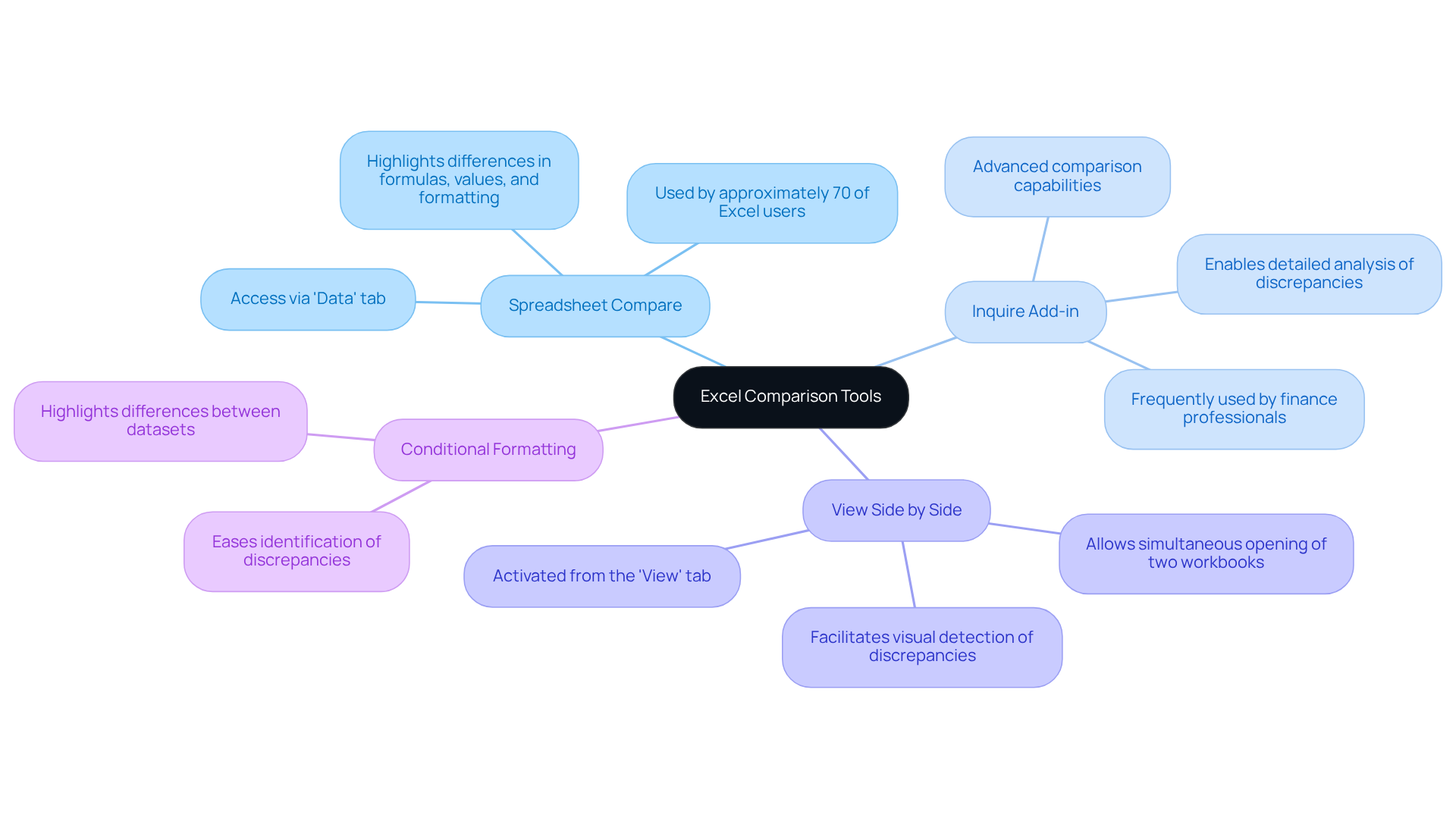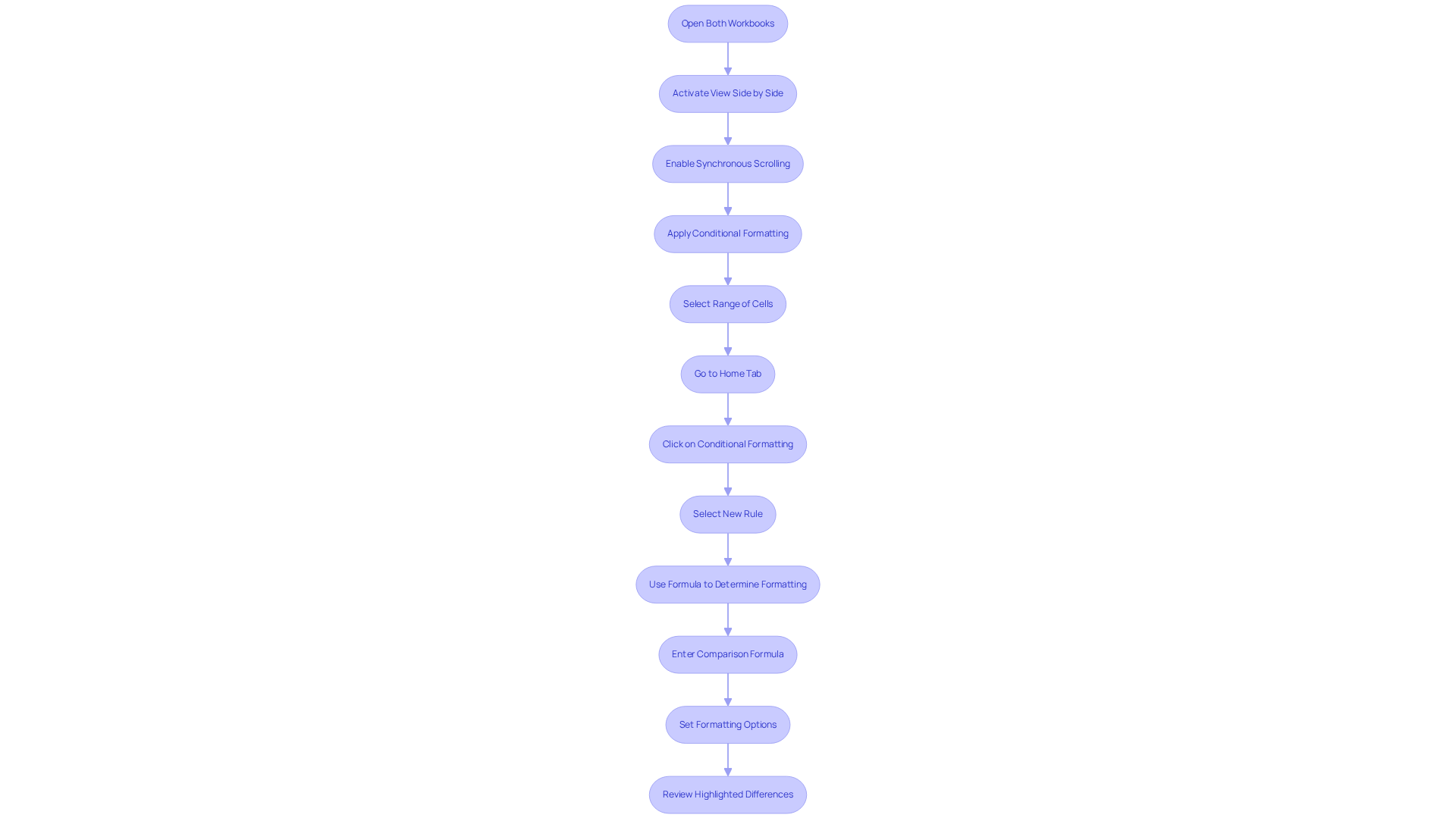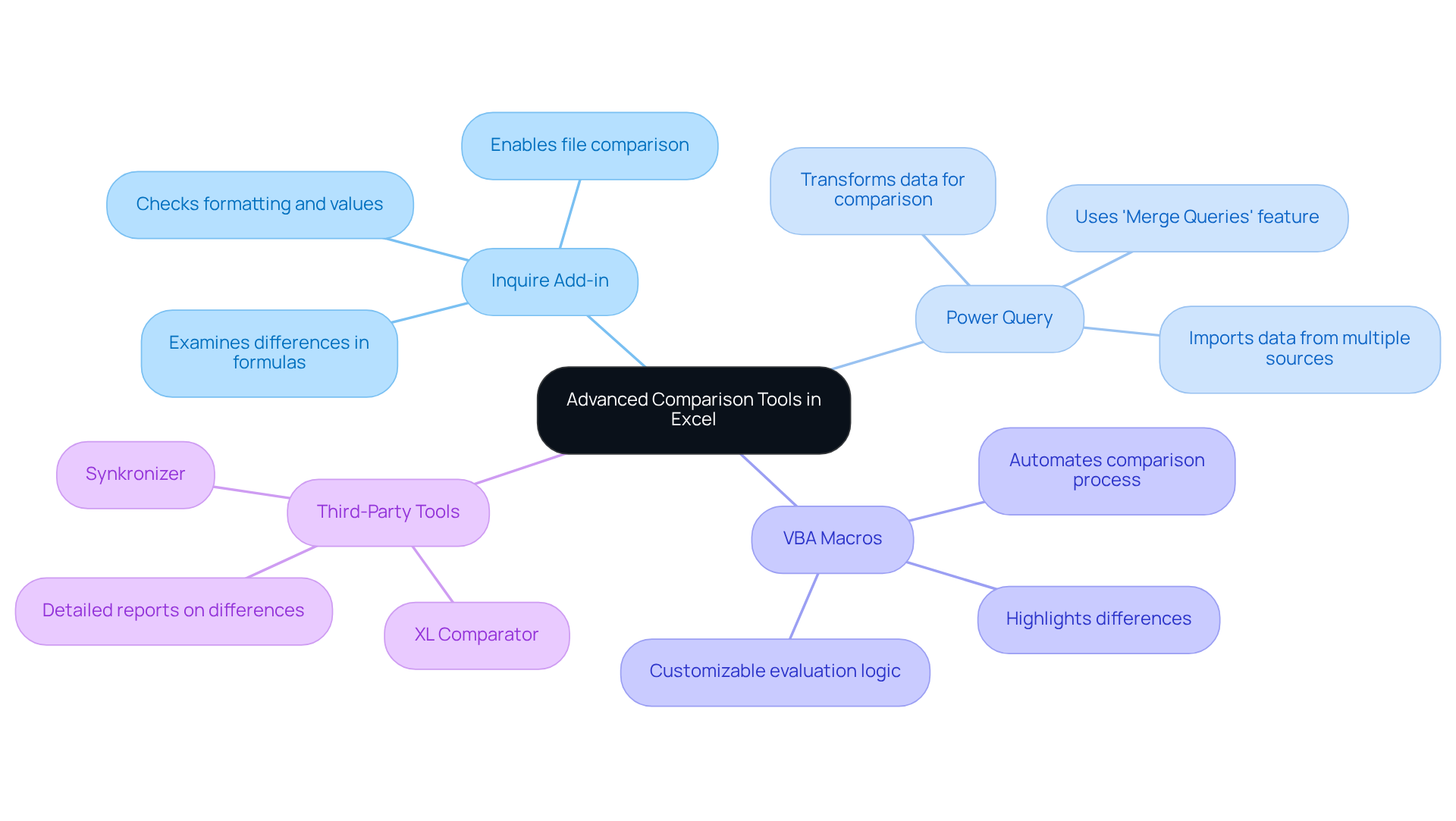Overview
This article addresses the challenges finance professionals face when comparing Excel files, presenting essential techniques that enhance efficiency and accuracy. It highlights powerful tools such as:
- Spreadsheet Compare
- the Inquire Add-in
- conditional formatting
These built-in features are crucial as they significantly improve data accuracy and integrity. By enabling users to swiftly identify discrepancies, these tools streamline the evaluation process, which is vital for effective financial reporting. Embracing these solutions not only simplifies workflows but also enhances the overall reliability of financial data.
Introduction
Excel has emerged as an indispensable tool for finance professionals. Yet, many users overlook its powerful comparison features. Understanding how to effectively compare Excel files can significantly enhance data accuracy and integrity, ensuring that financial analyses remain reliable.
With various tools available, how can one determine the most effective method for their specific needs? This article delves into essential techniques and advanced tools for comparing Excel files, empowering finance experts to streamline workflows and maintain impeccable data quality.
Understand Comparison Tools in Excel
Excel provides a range of built-in resources designed for efficient comparison of Excel files, an essential task for finance professionals who need to ensure data accuracy and integrity. Among the key features are:
-
Spreadsheet Compare: This powerful tool enables users to compare two versions of a workbook, clearly highlighting differences in formulas, values, and formatting. Access it via the 'Data' tab by selecting 'Compare Files'. Notably, approximately 70% of Excel users utilize this tool to compare Excel files and enhance their data verification processes.
-
Inquire Add-in: This add-in offers advanced comparison capabilities, allowing for a detailed analysis of discrepancies. To enable it, navigate to 'File' > 'Options' > 'Add-ins'. Real-world applications indicate that finance professionals frequently rely on the Inquire Add-in for complex financial analyses, significantly boosting their efficiency and accuracy.
-
View Side by Side: This function permits users to open two workbooks simultaneously and scroll through them together, facilitating the visual detection of discrepancies. Activate it from the 'View' tab.
-
Conditional Formatting: This tool can be employed to highlight differences between two datasets within the same sheet, making it easier to identify discrepancies at a glance.
Utilizing these resources can greatly enhance your effectiveness in conducting detailed evaluations, ensuring that your information remains precise and trustworthy. A significant percentage of spreadsheet users leverage these built-in features to compare Excel files, underscoring their critical role in daily operations. As noted by data analysts, "The ability to quickly identify discrepancies using tools like Spreadsheet Compare is invaluable in maintaining data integrity in financial reporting.

Utilize Side-by-Side and Conditional Formatting Techniques
To effectively compare two Excel files using side-by-side and conditional formatting techniques, follow these steps:
- Open Both Workbooks: Begin by opening the two Excel files you wish to compare.
- Activate View Side by Side: Navigate to the 'View' tab and click on 'View Side by Side'. This feature allows you to compare Excel files by viewing both workbooks adjacent to each other, simplifying your evaluation process.
- Enable Synchronous Scrolling: Activate 'Synchronous Scrolling' to ensure that scrolling in one workbook automatically scrolls the other, facilitating a direct evaluation of corresponding data.
- Apply Conditional Formatting:
- Select the range of cells in one workbook that you want to compare.
- Go to the 'Home' tab, click on 'Conditional Formatting', and select 'New Rule'.
- Choose 'Use a formula to determine which cells to format'. Enter a formula that compares the two datasets, such as
=A1<>Sheet2!A1to compare cell A1 in both sheets. - Set the formatting options to highlight differences, such as a specific fill color.
- Review Highlighted Differences: After applying the conditional formatting, any discrepancies between the two datasets will be highlighted, enabling quick identification of differences.
By mastering these techniques, you can streamline your evaluation process and significantly enhance your capabilities to compare Excel files.

Leverage Advanced Tools and Features for Efficient Comparisons
To enhance your comparison capabilities in Excel, consider utilizing the following advanced tools and features:
-
Using the Inquire Add-in:
- If you haven't already, enable the Inquire add-in by navigating to 'File' > 'Options' > 'Add-ins'. From the Manage dropdown, select 'COM Add-ins' and check 'Inquire'.
- Once enabled, access it from the 'Inquire' tab. Utilize the tool to compare Excel files and examine differences in detail, including formulas, formatting, and values.
-
Power Query:
- Power Query serves as a powerful tool to import and transform data from multiple sources. Load both datasets into Power Query and employ the 'Merge Queries' feature to compare them based on specific criteria.
- This method is particularly beneficial for large datasets where manual evaluation would be impractical.
-
VBA Macros:
- For users comfortable with programming, creating a VBA macro can automate the comparison process. This allows for personalized evaluation logic tailored to specific requirements.
- You can write a macro that loops through each cell in the datasets, highlighting differences or generating a summary report.
-
Third-Party Tools:
- Consider utilizing third-party comparison tools such as Synkronizer or XL Comparator, which offer enhanced features for comparing Excel files. These tools provide detailed reports on differences and can even combine changes if necessary.
By leveraging these advanced tools and features, you can significantly improve your efficiency and accuracy to compare Excel files, thereby making your financial analysis more robust.

Conclusion
Mastering the art of comparing Excel files is essential for finance professionals who depend on accuracy and precision in data management. By understanding and utilizing the various comparison tools available in Excel, users can significantly enhance their ability to detect discrepancies, thereby ensuring that their financial reports are both reliable and trustworthy.
This guide has highlighted several key techniques, including:
- The use of Spreadsheet Compare
- The Inquire Add-in
- Side-by-side viewing
Each of these tools provides unique advantages, facilitating the efficient identification of differences in formulas, values, and formatting. Furthermore, advanced features such as Power Query and VBA macros empower users to streamline their comparison processes, making it easier to manage large datasets and automate repetitive tasks.
In a landscape where data integrity is paramount, embracing these Excel comparison techniques is not merely beneficial; it is essential. By implementing these strategies, finance professionals can enhance their analytical capabilities and ensure that their financial analyses remain robust. As the realm of data management continues to evolve, staying adept with these tools will not only improve operational efficiency but also foster a culture of accuracy and diligence in financial reporting.
Frequently Asked Questions
What is the purpose of comparison tools in Excel?
Comparison tools in Excel are designed to help users efficiently compare Excel files, ensuring data accuracy and integrity, which is particularly essential for finance professionals.
What is the Spreadsheet Compare tool?
Spreadsheet Compare is a powerful tool that allows users to compare two versions of a workbook, highlighting differences in formulas, values, and formatting. It can be accessed via the 'Data' tab by selecting 'Compare Files'.
How widely is the Spreadsheet Compare tool used?
Approximately 70% of Excel users utilize the Spreadsheet Compare tool to enhance their data verification processes.
What is the Inquire Add-in and how is it used?
The Inquire Add-in offers advanced comparison capabilities for a detailed analysis of discrepancies. To enable it, users should navigate to 'File' > 'Options' > 'Add-ins'. It is frequently used by finance professionals for complex financial analyses.
What does the View Side by Side feature do?
The View Side by Side feature allows users to open two workbooks simultaneously and scroll through them together, making it easier to visually detect discrepancies. It can be activated from the 'View' tab.
How can Conditional Formatting be used for comparison?
Conditional Formatting can be used to highlight differences between two datasets within the same sheet, allowing users to identify discrepancies at a glance.
Why are these comparison tools important for financial reporting?
These tools are critical in maintaining data integrity in financial reporting by enabling quick identification of discrepancies, which is invaluable for ensuring accurate and trustworthy information.

